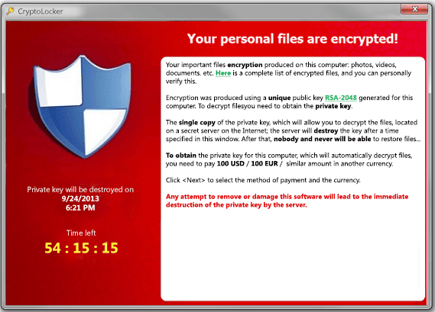If there’s one thing that should be at the top of a list of requirements to run a successful business, it should be a strong security system. This should not only include a system that protects the physical components of your business, but the technological portion as well. This includes your computers, servers, and other information technology devices. Every day, new threats are lurking on the internet that attempt to break into your system and manipulate your data. One of the most detrimental threats present on the internet today is known as ransomware. The objective of ransomware is to encrypt your data and hold it ransom until you pay them. One of the most common forms of ransomware is the CryptoLocker virus.
CryptoLocker, or Crypto for short, is a virus that attempts to encrypt your data on your computer. There are multiple variations to this virus, but the most common infections attack either your documents, pictures, music, etc, or your system files. When Crypto attacks your system files, it can lock up your entire operating system, rendering it inoperable. In addition, Crypto infections can spread to a server as well if your computer is connected to that server in some shape or form, such as a network drive. Once infected, the virus will encrypt its target without you noticing. When finished, a notification will appear on your computer, either on the desktop or inside a folder, to tell you that your data is encrypted. The message will tell you the only way to decrypt your files is to pay the ransom fee, which can range from hundreds to thousands of dollars. This is the reason why a Crypto infection is referred to as a form of ransomware.
There are multiple methods for an infection to occur, but the most common occurrences of Crypto occur due to an end user opening a suspicious email attachment or browsing infected websites. Historically, Crypto was discovered in 2013 and has been most prevalent in the United States (Symantec, http://www.symantec.com/connect/blogs/cryptolocker-qa-menace-year).
It’s important to note that this kind of infection can occur to anybody, including the most experienced technicians. There are steps you can take to prevent an infection. First, keep your antivirus programs up-to-date and refrain from opening suspicious emails or websites. Another important step to take is to create a backup system so that if in the event an infection occurs at your business, your data is safe. Paying the ransom fee will not guarantee the return of your files. By creating a backup system and keeping it up-to-date, you will not lose any of your data.
Finally, the most important thing to do is to always notify your IT support if you suspect a CryptoLocker infection. Some end users do not say anything to anybody because they’re uninformed or they’re afraid of the consequences they may face when management finds out about the infection. It’s always better to be honest and notify your IT support immediately, as this can mitigate the damage and potentially save your business from any further damage.

